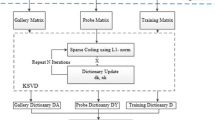Abstract
Appearance-based methods in face recognition have become one of the dominant techniques in recent years. Several studies have demonstrated that feature space is no longer critical in face recognition when the probe image can be approximated by a linear combination of training samples. However, in real-world application of face recognition, there are limited or even a single training sample per subject available. The availability of insufficient training samples often results in poor generalization ability for the existing state-of-the-art appearance-based methods. In this work, to address single-sample per person problem, we extend collaborative representation-based classification using \(l_{2}\) minimization approach, named extended collaborative neighbor representation (ECNR) that exploits the representational ability of training samples and intrapersonal variation from generic subjects. The proposed method is based on the assumption that intrapersonal variations from generic subjects are sharable across training dictionary. ECNR expresses a test sample as the linear combination of optimal neighbor bases from the single class-specific training dictionary and the intrapersonal variant bases from an auxiliary generic subjects dictionary with multiple samples per subject to represent the possible variations in testing and training samples. The resulting coding scheme is sparse in terms of original bases and is computationally efficient. Experiments on real-world face data sets have demonstrated the usefulness of the proposed method in single-sample face recognition tasks.









Similar content being viewed by others
References
Zhang D, Yang M, Feng X (2011) Sparse representation or collaborative representation: which helps face recognition. In: IEEE international conference on computer vision (ICCV). IEEE, pp 471-478
Waqas J, Yi Z, Zhang L (2013) Collaborative neighbor representation based classification using l2-minimization approach. Pattern Recognit Lett 34(2):201–208
Deng W, Jiani H, Jun G (2012) Extended SRC: undersampled face recognition via intraclass variant dictionary. IEEE Trans Pattern Anal Mach Intell 34(9):1864–1870
Wright J, Yang AY, Ganesh A, Sastry SS, Ma Y (2009) Robust face recognition via sparse representation. IEEE Trans Pattern Anal Mach Intell 31(2):210–227
Tan X, Chen S, Zhou ZH, Zhang F (2006) Face recognition from a single image per person: a survey. Pattern Recognit 39(9):1725–1745
Mi J-X, Huang D-S, Wang B, Zhu X (2013) The nearest-farthest subspace classification for face recognition. Neurocomputing 113:241–250
Qiao L, Chen S, Tan X (2010) Sparsity preserving discriminant analysis for single training image face recognition. Pattern Recognit Lett 31(5):422–429
Xu Y, Zhu Q, Fan Z, Wang Y, Pan JS (2013) From the idea of sparse representation to a representation-based transformation method for feature extraction. Neurocomputing 113:168–176
Kan M, Shan S, Su Y, Chen X, Gao W (2011) Adaptive discriminant analysis for face recognition from single sample per person. In: Automatic face & gesture recognition and workshops (FG 2011) 21–25 March, pp 193–199
Wang B, Li W, Li Z, Liao Q (2013) Adaptive linear regression for single-sample face recognition. Neurocomputing 115:186–191
Zhu Y, Li X et al (2013) Using the original and symmetrical face training samples to perform representation based two-step face recognition. Pattern Recognit 46(4):1151–1158
Gou J, Yi Z (2013) Locality-based discriminant neighborhood embedding. Comput J 56(9):1063–1082
Mi J-X, Liu J-X (2013) Face recognition using sparse representation-based classification on K-nearest subspace. PloS One 8(3):e59430
Martinez A, Benavente R (1998) The AR face database. CVC Tech, Report 24
Samaria FS, Harter AC (1994) Parameterisation of a stochastic model for human face identification. In: IEEE workshop on applications of computer vision, pp 138–142
Lee KC, HO J, Kriegman D (2005) Acquiring linear subspaces for face recognition under variable lighting. IEEE Trans Pattern Anal Mach Intell 27(5):684–698
Berg D, Friedlander E (2008) Probing the Pareto frontier for basis pursuit solutions. SIAM J Sci Comput 31(2):890–912
SPGL1: a solver for large-scale sparse reconstruction. http://www.cs.ubc.ca/labs/scl/spgl1
Xu Y, Zhu Q, Fan Z, Qiu M, Chen Y, Liu H (2013) Coarse to fine K nearest neighbor classifier. Pattern Recognit Lett 34(9):980–986
Xu Y, Zhang D, Yang J, Yang JY (2011) A two-phase test sample sparse representation method for use with face recognition. IEEE Trans Circuits Syst Video Technol 21(9):1255–1262
Waqas J, Yi Z, Zhang L (2014) Graph based features extraction via datum adaptive weighted collaborative representation for face recognition. Int J Pattern Recognit Artif Intell 28(2):1451003-1–1451003-27
Acknowledgments
This work was supported by National Basic Research Program of China (973 Program) under Grant 2011CB302201 and National Nature Science Foundation of China under Grant Number 61003042.
Author information
Authors and Affiliations
Corresponding author
Rights and permissions
About this article
Cite this article
Jadoon, W., Zhang, L. & Zhang, Y. Extended collaborative neighbor representation for robust single-sample face recognition. Neural Comput & Applic 26, 1991–2000 (2015). https://doi.org/10.1007/s00521-015-1843-x
Received:
Accepted:
Published:
Issue Date:
DOI: https://doi.org/10.1007/s00521-015-1843-x




